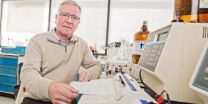(Press-News.org) Low-molecular-weight heparin is commonly used in surgeries to prevent dangerous blood clots. But when patients experience the other extreme – uncontrolled bleeding – in response to low-molecular-weight heparin, there is no antidote.
Now researchers at the University of North Carolina at Chapel Hill and Rensselaer Polytechnic Institute have created a synthetic form of low-molecular-weight heparin that can be reversed if things go wrong and would be safer for patients with poor kidney function.
"When doctors talk to me about the kind of heparin they want to use during and after surgery, they want it reversible, and they want it to not go through the kidneys," said Jian Liu, the John A. and Deborah S. McNeill Jr. Distinguished Professor in the UNC Eshelman School of Pharmacy, and one of the inventors of the new drug.
While unfractionated heparin is the type commonly used in procedures such as dialysis, the more-refined low-molecular-weight heparins are the drugs of choice for preventing dangerous blood clots in hospitalized patients. However, low-molecular-weight heparin doesn't have an antidote and it is also cleared from the body by the kidneys, which can make it unsuitable for patients with a weakened kidney function, a relatively common condition among hospitalized patients.
Liu and RPI's Robert Lindhardt and their teams created a synthetic version of low-molecular-weight heparin that can be counteracted by an existing drug and can be cleared by the liver, not the kidneys. Their creation is described in Nature Chemical Biology this week.
Up to 5 percent of patients receiving heparin experience some form of uncontrolled bleeding, explained Liu. Patients receiving unfractionated heparin are in less danger because there is an existing FDA-approved antidote available. The antidote, called protamine, is not as effective in reversing low-molecular-weight heparin so Liu and Lindhardt tweaked the drug's molecular structure so that protamine is able to deactivate it.
"If a person's kidneys aren't effectively clearing heparin from the blood, the drug stays active in the body for longer than expected," said Nigel Key, a hematologist with UNC Health Care and the UNC School of Medicine and one of the paper's coauthors. "That can represent a potentially dangerous situation for the physician, pharmacist and patient."
Heparin prevents blood clots from forming and is most often used during and after such procedures as kidney dialysis, heart bypass surgery, stent implantation, indwelling catheters and knee and hip replacement. Its side effects can include uncontrolled bleeding and thrombocytopenia (too few platelets in the blood). The worldwide sales of heparin are estimated at $4 billion annually.
The natural form of the drug was in the spotlight in spring 2008 when more than eighty people died and hundreds of others suffered adverse reactions to it, leading to recalls of heparin in countries around the world. Authorities linked the problems to a contaminant in raw natural heparin from China. Natural heparin is most commonly extracted from the linings of pig intestines.
"The pig stuff has served us well for fifty years and is very inexpensive, but if we cannot control the supply chain, we cannot ensure the safety of the drug," Liu said. "I am working for the day when synthetic heparin can be brewed in large laboratories at a low cost."
INFORMATION:
School of Pharmacy contact: David Etchison, (919) 966-7744, david_etchison@unc.edu
News Services contact: Thania Benios, (919) 962-8596, thania_benios@unc.edu
Antidote can deactivate new form of heparin
2014-02-26
ELSE PRESS RELEASES FROM THIS DATE:
Surge in designer drugs, tainted 'E' poses lethal risks
2014-02-26
In the span of a decade, Canada has gone from ecstasy importer to global supplier of the illegal party drug. At the same time, even newer designer highs—sometimes just a mouse-click away—are flooding the drug market faster than legislation can keep pace.
It's a worrying problem that University of Alberta researchers say requires more education to help Canadians understand the very real, deadly risks of designer drug use.
"The chemists who are making these drugs are coming up with about 10 new drugs per year; the legislation cannot keep up with the market," said Alan ...
Study shows why breastfed babies are so smart
2014-02-26
Loads of studies over the years have shown that children who were breastfed score higher on IQ tests and perform better in school, but the reason why remained unclear.
Is it the mother-baby bonding time, something in the milk itself or some unseen attribute of mothers who breastfeed their babies?
Now a new study by sociologists at Brigham Young University pinpoints two parenting skills as the real source of this cognitive boost: Responding to children's emotional cues and reading to children starting at 9 months of age. Breastfeeding mothers tend to do both of those ...
Still-fresh remnants of Exxon Valdez oil protected by boulders
2014-02-26
HONOLULU – Twenty-five years after the infamous Exxon Valdez oil spill in Prince William Sound, beaches on the Alaska Peninsula hundreds of kilometers from the incident still harbor small hidden pockets of surprisingly unchanged oil, according to new research being presented here today.
The focus of the study is to learn how oil persists long after a spill. Researchers presenting the work caution that the amount of oil being studied is a trace of what was originally spilled and that results from these sites cannot be simply extrapolated to the entire spill area.
The ...
Fox Chase researchers discover new mechanism of gene regulation
2014-02-26
In the cells of humans and other organisms, only a subset of genes are active at any given time, depending largely on the stage of life and the particular duties of the cell. Cells use different molecular mechanisms to orchestrate the activation and deactivation of genes as needed. One central mechanism is an intricate DNA packaging system that either shields genes from activation or exposes them for use.
In this system, the DNA strand, with its genes, is coiled around molecules known as histones, which themselves are assembled into larger entities called nucleosomes. ...
Harvested rainwater harbors pathogens
2014-02-26
South Africa has been financing domestic rainwater harvesting tanks in informal low-income settlements and rural areas in five of that nation's nine provinces. But pathogens inhabit such harvested rainwater, potentially posing a public health hazard, especially for children and immunocompromised individuals, according to a team from the University of Stellenbosch. The research was published ahead of print in Applied and Environmental Microbiology.
International studies had indicated that harvested rainwater frequently harbors pathogens, and that, in light of the financing ...
No warming hiatus for extreme hot temperatures
2014-02-26
Extremely hot temperatures over land have dramatically and unequivocally increased in number and area despite claims that the rise in global average temperatures has slowed over the past 10 to 20 years.
Scientists from the ARC Centre of Excellence for Climate System Science and international colleagues made the finding when they focused their research on the rise of temperatures at the extreme end of the spectrum where impacts are felt the most.
"It quickly became clear, the so-called "hiatus" in global average temperatures did not stop the rise in the number, intensity ...
Beta-catenin alters T cells in lasting and harmful ways
2014-02-26
Activation of beta-catenin, the primary mediator of the ubiquitous Wnt signaling pathway, alters the immune system in lasting and harmful ways, a team of Chicago-based researchers demonstrate in the February 26, 2014, issue of Science Translational Medicine.
An increase in beta-catenin in certain types of T cells—a class of white blood cells—causes chronic inflammation in the intestine and colon, eventually leading to cancer. The same mechanism is used by colon cancer to propagate itself. The researchers combine data from patients suffering from colitis or colon cancer ...
Hubble monitors supernova in nearby galaxy M82
2014-02-26
This is a Hubble Space Telescope composite image of a supernova explosion designated SN 2014J in the galaxy M82. At a distance of approximately 11.5 million light-years from Earth it is the closest supernova of its type discovered in the past few decades. The explosion is categorized as a Type Ia supernova, which is theorized to be triggered in binary systems consisting of a white dwarf and another star — which could be a second white dwarf, a star like our sun, or a giant star.
Astronomers using a ground-based telescope discovered the explosion on January 21, 2014. This ...
Characterization of stink bug saliva proteins opens door to controlling pests
2014-02-26
Brown marmorated stink bugs cause millions of dollars in crop losses across the United States because of the damage their saliva does to plant tissues. Researchers at Penn State have developed methods to extract the insect saliva and identify the major protein components, which could lead to new pest control approaches.
"Until now, essentially nothing was known about the composition of stink bug saliva, which is surprising given the importance of these insects as pests and the fact that their saliva is the primary cause of feeding injury to plants and crop losses," said ...
New data book outlines Hispanic/Latino health
2014-02-26
The National Heart, Lung, and Blood Institute, part of the National Institutes of Health, released the largest and most comprehensive health and lifestyle analysis of people from a range of Hispanic/Latino origins. The data will enable individuals, communities, and policy makers to tailor better health intervention strategies.
"This study lays the foundation for future research on the possible causes of chronic diseases and ways to prevent them, and to help us understand the reasons why Hispanics and Latinos live longer than the general population," said Gregory Talavera, ...





